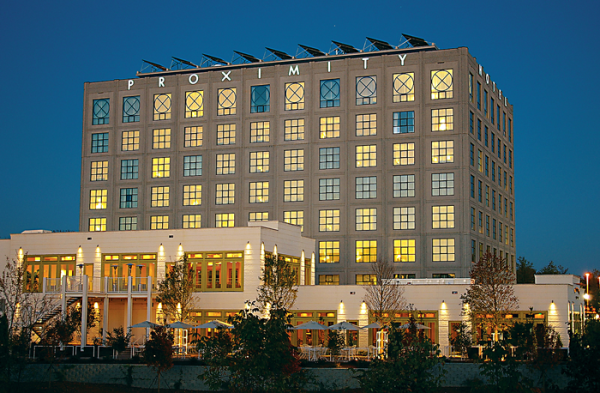 When Dennis Quaintance decided to build the Proximity Hotel in Greensboro, North Carolina, he knew he wanted the hotel’s design to exceed industry standards for environmental quality. He also knew he wanted the Proximity’s daily operation to reflect a reduction in energy consumption, as compared to similar hotels.
When Dennis Quaintance decided to build the Proximity Hotel in Greensboro, North Carolina, he knew he wanted the hotel’s design to exceed industry standards for environmental quality. He also knew he wanted the Proximity’s daily operation to reflect a reduction in energy consumption, as compared to similar hotels.
The idea of building an environmentally responsible hotel was challenging. How could a hotel use less energy and water, continuously employ cost-saving measures, and still uphold its luxury appeal to hundreds of guests and visitors each day?
The services of Adams Environmental Systems, Inc., were employed to assist in meeting this challenge. Adams Environmental used its expertise in air quality monitoring, solar energy, and building structures to design and install an extensive monitoring system to integrate many of the hotel’s sustainable practices and provide comprehensive real-time data. This monitoring system extends throughout the hotel property, including its adjoining restaurant.
- Weather station – Measures outdoor air temperature and humidity.
- BTU meter – Employed in the solar panel system on the facility’s roof to monitor solar hot water production for bathing, cooking, and laundry
- Carbon dioxide, air temperature, and humidity sensors – Monitor the indoor air quality of various rooms in the facility. Using the datalogger and communication peripheral, an alarm is triggered if a room’s carbon dioxide level reaches a preset level.
- Heat, smoke, and other effluent sensors – Maintain fresh airflow in the restaurant’s kitchen. The datalogger adjusts the power of the ventilation hoods’ variable-speed fans to match the kitchen’s needs. Typically, these fans have operated at 25 percent of full capacity.
- Energy usage monitoring – Determines air conditioning, lighting, electricity, and natural gas usage to calculate energy efficiency.
To accommodate the many different types of sensors used throughout the facility, Adams Environmental used Campbell Scientific’s most widely used datalogger, the CR1000, with the SDM-IO16 input/output expansion module. The NL120 Ethernet interface communicates the data wirelessly to a central display kiosk in the hotel lobby. Campbell’s LoggerNet software produces graphical displays of the real-time data.
Because of all the sustainability measures taken to create and maintain an environmentally responsible hotel, the Proximity Hotel and its adjoining Print Works Bistro became the first facility in the hospitality industry to obtain the U.S. Green Building Council’s platinum rating for Leadership in Energy and Environmental Design (LEED).
The achievement of management’s sustainability goals, the continued use of sustainability practices, and management’s desire to further improve the hotel’s energy efficiency are evidenced by the data supplied by the monitoring system. Using this system, the facility’s actual energy use is compared to the projected use. With this type of feedback, hotel management can make informed decisions regarding improvements throughout the facility. This feedback, for example, has led to a change to the solar system that increased its BTU output by 20 percent. Overall, compared to similar hotels, this facility uses approximately 34 percent less water and 39 percent less energy.
By using less water and energy, and continuing to monitor its usage, the hotel has proven to be a cost-saving facility. As one example of these savings, the hotel was able to save $2,000 a month just by monitoring the HVAC system. It is important to note that the impact of savings like these was not negated by a significant additional cost for construction--less than $7,000 was spent for sustainability improvements during construction.
The facility’s sustainability practices, while benefitting both management and the environment, have not negatively impacted the comfort level of guests and visitors. In fact, the luxury hotel has continued to be recognized for its green practices while it has received praise from its patrons. Behind the scenes, the monitoring system installed by Adams Environmental continues to promote the hotel’s sustainability practices.